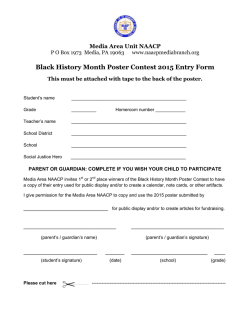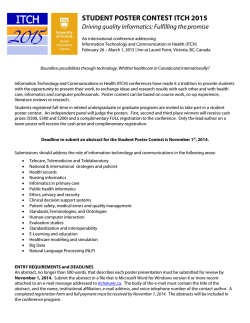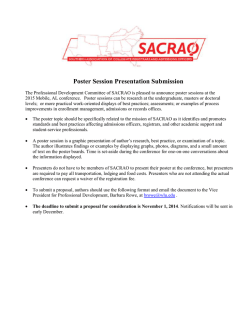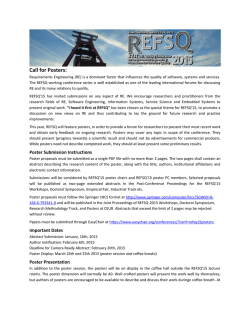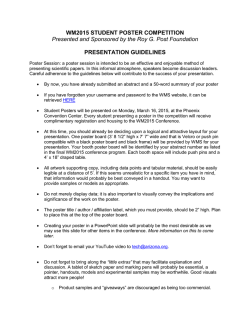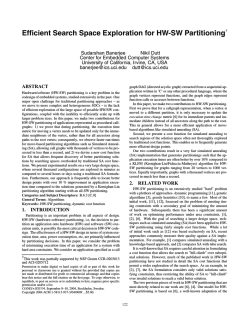
Project Awards 2015 Poster Presenters Guide
Project Awards 2015 Poster Presenters Guide Introduction As pharmacists, it is important to be able to communicate thoughts and ideas effectively, using a variety of tools. Whether presenting audit results in a hospital, looking at how a community pharmacy is performing with a new service or when you attend a conference, you will need to develop this skill throughout your career. If your project was shortlisted for a poster display at the Project Awards you have a great opportunity to acquire and develop your poster presentation skills and potentially obtain a prize if you are the poster winner or runner up. This guide contains information to help you improve your poster presentation skills. What is a poster? A poster visually conveys the essence of a message. It is a display of written / graphic information which is mounted on a board, a static, visual medium that can be used to communicate ideas and messages. You may wish to produce a professionally printed poster or make your own using a series of laminated Power Point slides that conform to the required dimensions. The content of your poster is important. Why a poster presentation? This is an opportunity to share the findings of your audit with your peers across London and Midlands & East (East of England - Beds, Essex & Herts). For the attendees, the key advantage is that, unlike a paper, information can be seen at a glance. You will not be required to stand next to your poster to answer any questions. As a means of communicating information, the poster display is an excellent opportunity to develop your skills and is a strong recognition of the quality of your work. Being asked to complete a poster presentation is an excellent achievement which you should state in future job applications as you develop your career. How much poster space are you allocated? Is there a standard format? London Pharmacy Education and Training (LPET) require posters to comply with the following: Maximum display space allocated per poster: vertical height 1 metre horizontal width 1 metre Orientation must be landscape Format of display Collection of A4 laminated PowerPoint slides or an A0 professionally produced poster You must work within the dimensions, as anything outside that will not fit on the poster boards. 2 The poster should include the following titles/ sections in a logical order: Title of the project, author(s) name, name of Organisation Introduction Aims and objectives Standards Method Results Discussion & Conclusion References Planning As soon as you are notified that you have been selected to present a poster, you may wish to make a booking with your Trust’s Medical Illustrations Department (discuss this with your project supervisor/ tutor / pre-reg. manager in the first instance as you may require a budget code). Time management You should allow yourself enough time to design your poster. If the Medical Illustration Department cannot work within your time frame, enquire whether they would provide you with the materials e.g. Velcro pads so you can work on your own design. You may also wish to look into external printers who may be able to print some of your content in the size and colour you need. If you are unable to produce one large poster via Medical Illustration or an external printer, you can consider another format which can involve a number of small (usually A4 sized) laminated PowerPoint slides arranged within your allocated space on the poster display board. This is a cost effective way to produce a poster in a short period of time and you have the advantage of being able to make last minute changes, the separate pieces can easily be carried to the venue. However, if you are going to use this format, make sure you allow yourself enough time to assemble the display on the day of the Project Awards. Transporting your poster Consider how your poster will be transported on the day. You may wish to equip yourself with a suitable artist’s portfolio or poster tube. LPET will supply stationery (i.e. Velcro stickers), so that you can mount your poster. You should ensure that your poster will be securely in place on the poster board for the whole day. To prevent problems on the day, test your poster by displaying it on a board at work, and see how long it stays up! Design This is crucial. Start with a draft and prioritise what information should be included. Remember, it should be a visual summary of your project. You will also need to experiment with different layouts and test your draft by showing it to a colleague from your department and use their feedback to improve your work. If you intend on using graphics or pictures, allow enough time for this to be produced. 3 Points to consider when designing your poster: Look at previous ones by former pre-registration trainee pharmacists from your department or speak to your Trust Medical Library. Decide what information you want to include (prioritise what is relevant and valid). Think about the key messages you want to convey. There should be enough information displayed in a selfexplanatory manner. Write and sketch out each section on a separate piece of paper for each of your sections, and lay it out. This will give you an idea of the overall appearance. In addition sketch out a plan of how all the sections fit together on one sheet. This design plan should be your starting point for your discussions with the Medical Illustration Department or external printers. Colourful flow-diagrams, histograms or pie charts should be used in preference to huge blocks of written text. A lot of information can be taken in at a glance when information is presented in a creative manner and bold illustrations always attract the reader’s eye. Number of patients within a specific TTR% range 60 Number of patients 50 40 30 20 10 0 0-40 41-50 51-60 61-70 71-80 81-90 91-100 Time in Therapeutic Range (%) You can use arrows to indicate the sequence that you want the reader to follow. It is best to use bullet-points for text as this makes it easier to read. Your text should be read in a number of narrow columns rather than in one wide column Your text may be creatively presented by “boxing” your sections. You could put some of your text next to the graphs, tables and pictures, ensuring they all follow a logical order and make a relevant point to your project When using text, it is best to write in an active rather than the passive voice. i.e. “the data demonstrates that….” Rather than “it can be demonstrated by the data that….” Explain all abbreviations when first used. Clearly label tables, graphs and pictures. The poster should be legible from a distance of about 1.5 metres. Avoid hand written information, as this may not be legible. Use the resources from the Medical Illustrations Department, or the external printers. Use colour and pictorial presentation of information. If you feel very confident, you may wish to use your computer graphics skills and come up with your own design using computer software. Make it attractive, and incorporate photographs where relevant. Use all blank space creatively. Use easy to read font and size for headings and text. 4 Presentation Headings Use different colours and even font sizes if you wish to highlight your headings. Use Arial font, this is more legible from a distance. For the overall title of the poster, make this creative so that it grabs the attention of your audience e.g. Audit on drug wastage will save XYZ Trust £1.2 million per year”. Colours Use colours which complement one another to emphasise, differentiate, and add interest to different sections of the poster. Try to use appropriate ones for text and background and avoid bright colours or those which make your poster difficult to read. Try not to use upper case as this is more difficult to read than lower case. Whichever method you choose to emphasise your points, keep this consistent. For instance, if you have used bold (rather than italics or a different colour) then use this throughout the poster. You should, where possible adhere to one font size (you may wish to use a bigger font size for sub headings and titles). Maintain consistency with your poster e.g. graphs and tables should be same size and at the same scale, especially if you want them compared. Also, think about the positions of your graphs, tables, illustrations and how it looks overall. It needs to flow well with rest of your text. Review, review, review! Check grammar and spelling of text. An outstanding piece of work can be marred by obvious spelling mistakes! Try different layouts for your poster. Ask your colleagues, friends or even a family member for an independent opinion. Best wishes with your poster presentation! References McGuire R; How to present a poster, Pharmaceutical Journal (Vol 270), 10 May 2003 Also accessible from: http://faculty.ksu.edu.sa/nsybarakat/poster%20presentation/How%20to%20present%20a%2 0poster.pdf (accessed on 25.03.2014) How to present a poster; UKCPA January 2012 http://www.ukcpa.net/wp-content/uploads/2012/01/How-to-present-a-poster-revised-AutSymp.pdf (accessed on 25.03.2014) University of Newcastle Upon Tyne, Chemical Engineering and Advanced Materials, Poster Presentation of research work http://lorien.ncl.ac.uk/ming/dept/Tips/present/posters.htm (accessed on 25.03.2014) 5
© Copyright 2026

